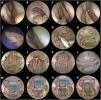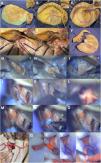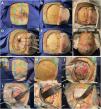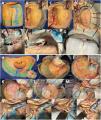The development of a high level of competence and technical proficiency is one of the main objectives of any neurosurgical training program. Due to many factors, this progressive skill development can be complex during the residency. Despite its high cost and infrastructure requirements, there is renewed interest regarding the role of anatomy labs. The study and dissection of the human cadaver has been the environment where many surgeons have developed the necessary skills for microneurosurgery. We propose a structured endoscopic and microsurgical training dissection program to enable residents to maximize the benefits of their training in the lab.
Material and methodsDuring the months of September, October and November 2021, a stay was done at the Microneurosurgery and Skull Base Laboratory of the Miguel Hernández University of Alicante. A total of 2 specimens were used. The first specimen underwent a first endoscopic endonasal dissection phase. After completing the endonasal part, a set of incisions were made to perform the transcranial part. In the second specimen, the transcranial part was performed first, leaving the endonasal endoscopic work for the last phase.
ResultsThe results of the dissection program are presented. During the endonasal endoscopic phase, the transsphenoidal approach to the sella was simulated while focusing on the extended approaches in the sagittal plane. During the transcranial phase, right and left anterolateral approaches, a left anterior transcallosal interhemispheric approach, a left transcondylar posterolateral approach and a combined right lateral approach were performed.
ConclusionsThe structured dissection of the specimen allowed both endonasal endoscopic and transcranial microsurgical training in the same specimen. This design facilitated the realization of the core skull base approaches in the same specimen. According to our initial experience, we believe that developing common dissection programs is a powerful tool to maximize the results of our residents’ laboratory training.
El desarrollo de una elevada capacidad crítica y competencia técnica constituye uno de los objetivos principales de todo programa de formación en Neurocirugía. Por múltiples factores, esta adquisición progresiva de habilidades técnicas puede resultar compleja durante la residencia. A pesar de su elevado coste y necesidad de infraestructura, existe un interés renovado respecto al papel de los laboratorios de anatomía. El estudio y disección del espécimen anatómico ha sido el contexto donde muchos neurocirujanos han desarrollado y perfeccionado la técnica microneuroquirúrgica. Proponemos un plan estructurado de disección y entrenamiento endoscópico y microquirúrgico que permita al residente obtener el máximo provecho durante su estancia en un laboratorio.
Material y métodosDurante los meses de septiembre, octubre y noviembre de 2021 se realizó una estancia en el Laboratorio de Microneurocirugía y Base Craneal de la Universidad Miguel Hernández de Alicante. Se emplearon un total de 2 especímenes formolados e inyectados con silicona roja y azul. En el primer espécimen se realizó una primera fase de disección endoscópica endonasal. Tras completar la fase endonasal se plantearon un conjunto de incisiones para realizar los abordajes transcraneales. En el segundo espécimen se realizó primero la parte transcraneal dejando el trabajo endoscópico endonasal para la segunda fase.
ResultadosSe muestran los resultados de la disección de los 2 especímenes. Durante la fase endoscópica endonasal se simuló el abordaje transesfenoidal a la silla incidiendo sobre los abordajes extendidos en el plano sagital. Durante la fase transcraneal se realizaron abordajes anterolaterales derecho e izquierdo, un abordaje interhemisférico transcalloso anterior izquierdo, un abordaje posterolateral transcondilar izquierdo y un abordaje lateral derecho combinado.
ConclusionesLa disección estructurada del espécimen permitió tanto el entrenamiento endoscópico endonasal como el transcraneal microquirúrgico en una misma pieza. Este planteamiento facilitó la realización de los principales abordajes basicraneales en un único espécimen. Tras nuestra experiencia inicial, creemos que la elaboración conjunta de planes de disección constituye una herramienta de gran ayuda para maximizar los resultados del trabajo de laboratorio de los residentes de neurocirugía.
Article

If it is the first time you have accessed you can obtain your credentials by contacting Elsevier Spain in suscripciones@elsevier.com or by calling our Customer Service at902 88 87 40 if you are calling from Spain or at +34 932 418 800 (from 9 to 18h., GMT + 1) if you are calling outside of Spain.
If you already have your login data, please click here .
If you have forgotten your password you can you can recover it by clicking here and selecting the option ¿I have forgotten my password¿.















